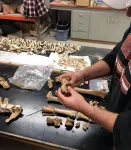(Press-News.org) NEWPORT, Ore. - Researchers can now determine the age and sex of living beluga whales in Alaska's Cook Inlet thanks to a new DNA-based technique that uses information from small samples of skin tissue.
Accurate age estimates are vital to conservation efforts for Cook Inlet belugas, which were listed as endangered following a significant population decline in the 1990s. Previously, researchers could only determine the age of beluga whales by studying the teeth of dead animals.
The new aging method uses DNA methylation data and machine learning to develop a model that captures the relationship between methylation and age. This relationship provides an epigenetic clock for beluga whales.
Epigenetics broadly refers to non-heritable molecular modifications of DNA that change the way genes function. Methylation is one form of epigenetics; it is a biological process by which methyl groups are added to the DNA molecule. In mammals, there are places along the genome that become more methylated as an animal ages.
The new method for determining Cook Inlet beluga whales' age represents a significant advance in understanding the life history of the species and will have applications to other whale species. The method also can be used to identify an animal's sex.
"The development of this tool and the use of the epigenetic clock is a major advance in the science of aging," said Eleanor Bors, the study's lead author. Bors worked on the project as a post-doctoral fellow at Oregon State University's Marine Mammal Institute. "We have the technology now to do this easily and it can become a routine part of research on beluga whales."
The researchers' findings were just published in the journal Evolutionary Applications. Co-authors include Scott Baker, associate director of OSU's Marine Mammal Institute; Paul Wade of NOAA's Alaska Fisheries Science Center; and Steve Horvath of the University of California, Los Angeles.
Beluga whales are known for their distinctive white color and rounded heads. They average 13 feet in length and 3,150 pounds, and have a lifespan of up to 80 years. They are found in Alaska and throughout the Arctic.
Cook Inlet beluga whales are a geographically and genetically distinct population that does not migrate. The population had numbered more than 1,000 in 1979 but declined sharply from 653 to 347 between 1994 and 1998, in part due to unregulated hunting.
Hunting regulations were implemented in 2000 but the population has not rebounded. Today there are an estimated 279 beluga whales in the population, and they have been designated one of NOAA's "Species in the Spotlight," an initiative to bring greater attention and resources to species most highly at risk of extinction.
A NOAA species recovery plan issued in 2016 highlighted the need to determine the age structure of the Cook Inlet beluga population to better understand growth, reproduction and survival rates.
In toothed whales and dolphins, age is typically determined by examining teeth, which record age in growth layers similar to tree rings. But that option is only available once an animal has died. Using genomic information, which can be collected with a small biopsy dart, is an important development in the study of living whales and dolphins.
Researchers were able to develop the DNA methylation technique in part because the beluga whale's genome had already been sequenced, Baker said.
Working with tissue samples from 67 dead whales, the researchers measured methylation levels across tens of thousands of sites in the genome and determined that an effective clock model could be built using just 23 sites related to aging.
The researchers used machine learning to develop an epigenetic age profile for the species based on their findings. Finally, researchers calibrated their findings against age information determined by teeth recovered from the same animals.
"With all of that information, we were able to accurately model the relationship between methylation and age," Bors said.
Once the profile was built, researchers analyzed skin samples collected between 2016 and 2018 from 38 living whales. They were able to estimate ages and identify the sex of the animals using DNA methylation.
The new aging method gives researchers an important piece of data to use in their work to understand and, they hope, identify ways to reverse the population decline, Wade said. For example, while belugas in other populations reach sexual maturity at about age 8 or 9, the researchers have found that among the Cook Inlet whales tested so far, just one between ages 10 and 19 was pregnant.
"If reproduction is substantially delayed like that, it's a signal that is surprising. That is an area we can explore further," said Wade. "We want to keep adding data to see what else we can learn. We see this aging technique as something we want to do routinely now."
As additional samples are collected, the age profile for the species should continue to calibrate and refine itself, Baker added.
One question for future research is whether this process for determining age is applicable to other beluga whale populations, or more broadly to other whales, dolphins and porpoises, the researchers said. Genetic information collected in the database also can be mined for other biological changes.
"There is a lot of interest in methylation as an indicator of stress, for example," Baker said. "I'm also interested in kinship relationships within the population, which will now be easier to determine by knowing the age of individuals."
INFORMATION:
The research was supported by a grant from the North Pacific Research Board and the Paul G. Allen Frontiers Group.
If you have a second, try typing "time management" into your favourite search engine.
You will get literally millions of results: books, tips, lessons, do's and don'ts.
It's a big industry. But as END ...
A new analysis of a horse previously believed to be from the Ice Age shows that the animal actually died just a few hundred years ago--and was raised, ridden and cared for by Native peoples. The study sheds light on the early relationships between horses and their guardians in the Americas.
The findings, published today in the journal American Antiquity, are the latest in the saga of the "Lehi horse."
In 2018, a Utah couple was doing landscaping in their backyard near the city of Provo when they unearthed something surprising: an almost complete skeleton of a horse about the size of a Shetland pony. Scientists and the media took note. Preliminary data suggested ...
For a girl in Ethiopia, her mother's wealth can protect her from becoming a child bride - but if a father prefers child marriage, his own wealth may increase the likelihood that she will be married before 18, according to a Rutgers University-New Brunswick study.
Published in the journal World Development, the study found that girls whose mothers have more asset holdings - a cellphone, bicycle, sewing machine, jewelry or other valuables - have a reduced rate of entering into a child marriage, while the rate is higher for girls whose fathers have more asset holdings.
"Child marriage is concerning from a human rights, health and economic perspective," said the study's author Felix Muchomba, assistant professor at the Rutgers School of Social Work. "Girls married before ...
Getting children to eat their vegetables can seem like an insurmountable task, but nutrition researchers at The University of Texas at Austin have found one way: school gardens and lessons on using what's grown in them.
Researchers worked with 16 elementary schools across Central Texas to install vegetable gardens and teach classes to students and parents about nutrition and cooking. In a study recently published in the END ...
Humans, wildlife, and the environment are all interconnected and play a role in one another's health and well-being. Sentinel species, such as birds, are good indicators of environmental health, and they can send subtle warning signs that humans may be in danger next.
In an experimental exposure study, Kendra Sewall, an associate professor of biological sciences in the College of Science, and a diverse team of scientists and students have found that lead levels like those reported in Flint, Michigan, can interfere with the neural mechanisms of vocal development of songbirds and affect mate attraction.
By examining the effects of lead exposure ...
Floating sea macro-litter is a threat to the conservation of marine ecosystems worldwide. The largest density of floating litter is in the great ocean gyres -systems of circular currents that spin and catch litter- but the polluting waste is abundant in coastal waters and semi closed seas such as the Mediterranean.
MARLIT, an open access web app based on an algorithm designed with deep learning techniques, will enable the detection and quantification of floating plastics in the sea with a reliability over 80%, according to a study published in the journal Environmental Pollution and carried out by experts ...
A new study led by the University of Kent's Durrell Institute of Conservation and Ecology (DICE) has found that elephants living around the world-famous Masai Mara National Reserve, Kenya, are crop-raiding closer to the protected area, more frequently and throughout the year but are causing less damage when doing so.
Findings show that the direct economic impact of this crop-raiding in the Trans Mara region has dropped, yet farmers have to spend more time protecting their fields, further reducing support for conservation in communities who currently receive few benefits from living with wildlife.
The research published by Biological Conservation ...
BUFFALO, N.Y. -- All things being equal, large, long-lived animals should have the highest risk of cancer.
The calculation is simple: Tumors grow when genetic mutations cause individual cells to reproduce too quickly. A long life creates more opportunities for those cancerous mutations to arise. So, too, does a massive body: Big creatures -- which have many more cells -- should develop tumors more frequently.
Why, then, does cancer rarely afflict elephants, with their long lifespans and gargantuan bodies? They are some of the world's largest land animals.
A new study delves into this ...
Laparoscopic surgery, a less invasive alternative to conventional open surgery, involves inserting thin tubes with a tiny camera and surgical instruments into the abdomen. To visualize specific surgical targets, ultrasound imaging is used in conjunction with the surgery. However, ultrasound images are viewed on a separate screen, requiring the surgeon to mentally combine the camera and ultrasound data.
Modern augmented reality (AR)-based methods have overcome this issue by embedding ultrasound images into the video taken by the laparoscopic camera. These AR methods precisely map the ultrasound data coordinates to the coordinates of the ...
Over the past 30 years, the use of soil fumigants and nematicides used to protect cole crops, such as broccoli and Brussel sprouts, against cyst nematode pathogens in coastal California fields has decreased dramatically. A survey of field samples in 2016 indicated the nematode population has also decreased, suggesting the existence of a natural cyst nematode controlling process in these fields.
Thanks to California's pesticide-use reporting program, nematologists have been able to follow the amounts of fumigants and nematicides used to control cyst nematodes over the past three decades.
"Application of these pesticides steadily declined until they were completely eliminated in ...






